Adding Personality to a Walk
Now that we understand the basic mechanics of walking, we can start adding some personality to the walk. How a character walks will tell you a lot about the character. An old person walks differently than a construction worker, who in turn walks differently than a fashion model. By shaping the character of the walk, you can give the audience a lot of information about your character.
Working with the Legs
The legs and feet are the foundation of the walk. Varying the way a character steps will affect how the walk appears to the audience. The width and length of the stride are two factors that can affect the character of a walk.
Stride Width
Varying the width of the stride can affect the perceived weight of the character. A wider stance is much more stable and indicates a heavier or stronger character. Placing the feet closer together makes the walk more delicate and feminine.
Animating the legs far apart creates a more stable walk.
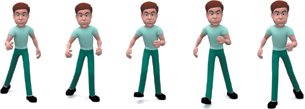
Animating the legs close together creates a more delicate walk.
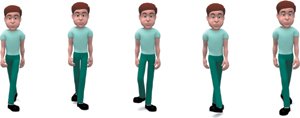
Stride Length
A character's stride length can also affect the character of the walk. If a character is determined, purposeful, or in a hurry, he will generally take longer steps. A timid, sad, or wandering character will take shorter steps.
Generally, characters take steps of equal length. If one leg takes shorter steps, it will appear to limp. In a similar vein, placing one foot wide can add interest to a walk as well.
This character is in a hurry, so he walks with a long stride.

This sad character walks with a shorter stride.

Using different strides on each leg creates a limp.
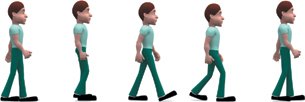
Working with the Hips
As a character walks, the hips will tend to sway from side to side. Amplifying or muting this motion can change the way the audience sees the walk. This motion is related to the stride width, as characters who walk with their feet closer together will need to sway the hips in order for the legs to pass each other. Women typically have more hip sway, the best example being runway models, who exaggerate this motion.
Working with the Arms
The way a character swings its arms can be very indicative of its mood and personality. While the typical arm motion of a walking character is to let the arms relax and swing like pendulums, adding a bit more purpose to this motion can add character.
A female character will typically walk with more hip sway.
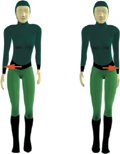
As the feet move closer together, the sway becomes more pronounced.
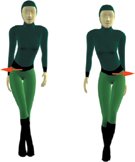
A timid character may have very little arm movement...

...while a proud character's arm movement adds to his strut.

Transitions |
Chapter One. Basics of Character Design
- Chapter One. Basics of Character Design
- Approaching Design as an Artist
- Design Styles
- Designing a Character
- Finalizing Your Design
Chapter Two. Modeling Characters
Chapter Three. Rigging Characters
- Chapter Three. Rigging Characters
- Hierarchies and Character Animation
- Facial Rigging
- Mesh Deformation
- Refining Rigs
- Conclusion
Chapter Four. Basics of Animation
- Chapter Four. Basics of Animation
- Understanding Motion
- Animation Interfaces
- The Language of Movement
- Secondary Action
- Conclusion
Chapter Five. Creating Strong Poses
- Chapter Five. Creating Strong Poses
- Posing the Body Naturally
- Creating Appealing Poses
- Animating with Poses
- Conclusion
Chapter Six. Walking and Locomotion
- Chapter Six. Walking and Locomotion
- The Mechanics of Walking
- Animating Walks
- Beyond Walking
- Adding Personality to a Walk
- Transitions
- Conclusion
Chapter Seven. Facial and Dialogue Animation
Chapter Eight. Animal Motion
Chapter Nine. Acting
- Chapter Nine. Acting
- Acting Vs. Animating
- Acting and Story
- Acting Technique
- Acting and the Body
- Other Techniques
- Conclusion
Chapter Ten. Directing and Filmmaking
EAN: 2147483647
Pages: 84
